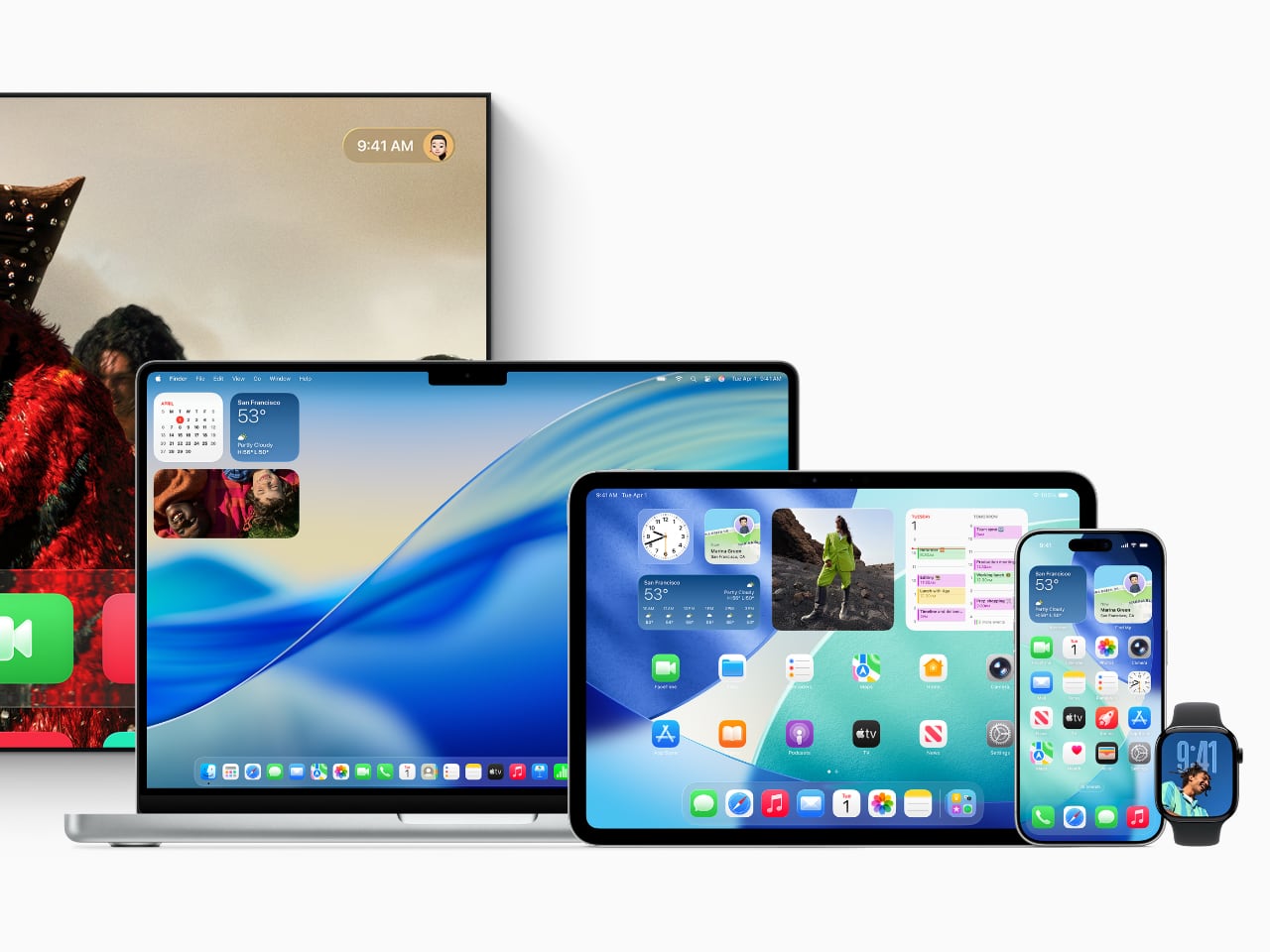Apple’s new Liquid Glass design language refracts light, adapts to context, and, for the first time, makes iPhone, iPad, Mac, Watch, TV, and Vision Pro feel like one family instead of six separate worlds. Today’s announcement of iOS 26, iPadOS 26, macOS Tahoe, watchOS 26, tvOS 26, and visionOS 26 finally addresses the fundamental interface problem that overwhelms users when every app competes for attention simultaneously.
Designer: Apple
Liquid Glass Design Philosophy Transforms How Interfaces Feel
For the first time, Apple has coordinated visual changes across all six platforms simultaneously while preserving what makes each operating system unique. This unified approach eliminates the jarring disconnection between devices that forces users to mentally readjust interfaces constantly.
Liquid Glass works as a translucent material inspired by visionOS that uses real-time specular highlights for depth and reflections while dynamically transforming to prioritize content over interface chrome. The system affects controls, navigation, app icons, widgets, and typography, not just window decoration.
Adaptive numerals shift based on context. Tab bars and sidebars resize intelligently as users scroll. Lock screen text adapts to underlying imagery for optimal readability. When reading articles, controls fade gracefully. During video editing, timeline tools become prominent while other elements recede naturally.
The philosophy demonstrates sophisticated restraint, recognizing that people switch between iPhone, iPad, and Mac throughout their workday constantly. Visual consistency reduces cognitive friction while platform-specific optimizations preserve each device’s core strengths.
However, this beauty comes with trade-offs. The GPU-intensive rendering means older hardware shows simplified effects. More critically, transparency looks gorgeous indoors but reduces contrast in direct sunlight. On iPhone 17 Pro, the translucency feels alive, though outdoors contrast sometimes slips, a fundamental tension between aesthetic appeal and practical usability that runs throughout Apple’s implementation.
Apple Intelligence Live Translation in iOS 26 Tackles Communication Barriers
International conference calls and travel create genuine language barriers that slow down professional work. Apple Intelligence introduces Live Translation across Messages, FaceTime, Phone calls, and AirPods without the awkward delays that plague existing translation tools.
The implementation supports English, French, German, Portuguese, Spanish, Chinese, Japanese, and Korean in beta, with additional language support rolling out throughout 2025. Visual intelligence gains ChatGPT integration for screenshot analysis plus search connections to Google, Etsy, and other supported applications for finding similar images and products.
Genmoji creation lets users combine multiple emoji for more precise expression than settling for approximate matches. Workout Buddy brings personalized spoken motivation to Apple Watch, iPhone, and AirPods during exercise sessions using generative voices built from Apple Fitness+ trainer data.
Developer Integration Expands Intelligence Ecosystem
New developer APIs let third-party apps integrate directly with on-device Apple Intelligence models. Apps like Streaks now intelligently suggest and categorize to-do items, while CARROT Weather provides unlimited conversational weather insights. Detail: AI Video Editor helps creatives by generating teleprompter scripts from outlines or existing text.
The on-device foundation model enables privacy-protected features that work offline, positioning Apple Intelligence as enhancement rather than replacement for human capabilities.
Liquid Glass in iOS 26 Eliminates Daily Phone Frustrations
Robocalls and customer service holds remain unnecessarily stressful despite decades of smartphone evolution. Call Screening automatically handles unknown numbers while Hold Assist waits on line until live agents become available, finally automating the tedious aspects of phone communication.
Lock Screen customization includes adaptive time presentation that adjusts to imagery and delightful 3D spatial scenes that respond to lighting conditions and usage patterns. The adaptive design ensures readability across different wallpapers and times of day.
Enhanced Communication and Media Features
Messages gains screening for unknown senders, poll creation, and conversation backgrounds. Apple Music adds Lyrics Translation and Pronunciation features for select songs across multiple language pairs. Apple Maps introduces Visited Places tracking while Apple Wallet expands order tracking capabilities in beta.
The new Apple Games app creates a personalized gaming destination for discovering and reconnecting with favorite titles. CarPlay users get a compact view for incoming calls, Tapbacks in Messages, plus widgets and Live Activities.
AirPods receive significant updates allowing creators to record high-quality content and remotely control Camera app capture, bridging professional and consumer workflows.
iPadOS 26 Desktop-Class Windowing Maintains Touch Simplicity
Professional iPad users have complained about windowing limitations for years without adequate solutions. iPadOS 26 introduces an entirely new windowing system that organizes and switches between apps while maintaining iPad’s signature simplicity, the biggest iPadOS release ever.
Multiple windows cooperate intelligently without the chaos that plagues traditional desktop environments. A new menu bar appears with a swipe down from the top or cursor movement to the edge, bridging touch and cursor interfaces elegantly without compromising either interaction method.
Home and lock screen widgets plus app icons gain a new “clear look” that integrates seamlessly with Liquid Glass principles. The aesthetic maintains visual hierarchy while reducing interface noise.
Professional Workflow Enhancements
The supercharged Files app offers new organization capabilities and folder customization. Dock folders provide convenient access to downloads and documents from anywhere. The Preview app arrives on iPad with Apple Pencil Markup and AutoFill integration, making document workflows seamless instead of requiring third-party workarounds.
Journal comes to iPad for capturing everyday moments and special events using Apple Pencil or touch. Creative professionals gain Background Tasks, enhanced audio input control, and high-quality local recording capabilities that bring iPad closer to desktop-class content creation.
On iPad M4, the new windowing system finally feels intuitive, but older models show lag when managing multiple windows simultaneously. It shows Apple’s design ambition outpacing its hardware support, a reminder that innovation always moves faster than compatibility.
macOS Tahoe Transparent Menu Bar Transforms Desktop Experience
Desktop search hasn’t fundamentally changed since the 1990s despite massive computing power increases. macOS Tahoe delivers Spotlight’s biggest update ever with new browsing views, enhanced search, and action capabilities for sending emails or creating events through quick keys.
Search transforms from file finding into a command center for everything. Shortcuts integrate with Apple Intelligence models for complex task automation. The updated Control Center offers new personalization options alongside extensive customization choices.
Visual Customization Meets Functional Design
Folder icons can be customized with color, symbols, or emoji. Wallpapers and tints interact directly with Liquid Glass elements, creating cohesive visual experiences that adapt to user preferences. The menu bar becomes completely transparent, expanding visual space without hardware changes.
Live Activities from iPhone now appear directly on Mac for real-time event tracking. Continuity brings iPhone Phone app features including Recents, Favorites, Voicemails, Call Screening, and Hold Assist directly to Mac, dissolving device boundaries.
On MacBook, the transparent menu bar is elegant at night but chaotic against a messy desktop, another example of the aesthetic versus practicality tension running throughout Liquid Glass implementation.
watchOS 26 Predictive Health Monitoring Gains FDA Validation
Fitness tracking has focused on reactive data collection rather than proactive health insights. Apple Watch gains a sleep score feature for understanding sleep quality and taking steps toward more restorative rest.
FDA-cleared hypertension notifications represent a significant medical advancement, alerting users when signs of chronic high blood pressure are detected so they can begin potentially lifesaving behavioral changes or treatment. The feature uses machine learning algorithms validated in large clinical studies but remains limited to Apple Watch Series 9 and later, Apple Watch Ultra 2 and later.
Enhanced Interaction and Productivity
watchOS 26 introduces two new watch faces: Flow and Exactograph. Smart Stack hints offer proactive prompts for actionable suggestions that appear when most relevant. Live Translation in Messages automatically translates texts into preferred languages.
A new wrist flick gesture dismisses notifications, silences alarms, and returns to the watch face on Series 9 and later models. On Apple Watch, wrist flick works instantly, while hypertension alerts inspire trust but raise accuracy questions. It positions Apple as both a lifestyle brand and a quasi-medical provider, which raises trust and liability questions. The Notes app finally arrives on Apple Watch, completing the productivity suite across Apple’s ecosystem.
Workout Buddy provides personalized, motivational audio insights during workouts with dynamic generative voices, while the Workout app debuts its biggest layout update since introduction.
Apple TV Social Features Transform Living Room Entertainment
Apple TV has lacked genuine social capabilities despite being shared household devices. Sing-along sessions reach new levels through Sing in Apple Music, transforming iPhones into wireless microphones for Apple TV with friends joining to queue songs or react with onscreen emoji.
Real-time lyrics and visual effects bring performances to life on the biggest screen in the home, making group entertainment interactive instead of passive consumption. Contact Posters on FaceTime simplify video calling from the living room while profile updates allow users to quickly return to personalized recommendations, playlists, and watchlists.
Vision Pro Persistent Spatial Computing Enables Collaboration
visionOS 26 brings powerful spatial experiences including widgets that integrate seamlessly into users’ spaces and persist across sessions instead of resetting each time. More expressive, realistic Personas and spatial scenes offer lifelike depth for photos.
Spatial browsing transforms Safari articles and lets developers embed 3D objects directly into web pages. Users can share Vision Pro experiences with people in the same room for collaborative movie watching or work sessions. iPhone unlocking while wearing Vision Pro plus hand and eye data saving makes sharing easier than ever.
A new interactive Jupiter environment lets users accelerate time to observe the planet’s massive storms swirling across its surface. Native playback support arrives for 180-degree, 360-degree, and wide field-of-view content from action cameras including Insta360, GoPro, and Canon models.
Comprehensive Accessibility Features Expand User Access
New accessibility features bring comprehensive customization to the Apple ecosystem. Accessibility Nutrition Labels on the App Store inform users of supported accessibility features before downloading apps, improving discoverability for users with disabilities.
The Magnifier app for Mac connects to external cameras for users with low vision to zoom in and interact with surroundings. Accessibility Reader offers systemwide reading mode with extensive font, color, and spacing options plus Spoken Content support.
Braille Access provides powerful interaction methods for braille users with connected displays. Live Listen controls come to Apple Watch with real-time Live Captions for users who are deaf or hard of hearing, ensuring the design revolution includes comprehensive user access.
Historical Context Reveals Design Evolution Strategy
Liquid Glass represents Apple’s most significant design evolution since the iOS 7 transformation from skeuomorphic to flat design in 2013. This latest pivot toward adaptive translucency aims to solve the interface chaos created by decades of feature accumulation across multiple platforms.
The simultaneous rollout across six platforms signals Apple’s confidence in unified design language while acknowledging the performance and usability trade-offs. GPU-intensive rendering limits older devices to simplified effects, and contrast issues in bright environments reveal the ongoing tension between beauty and functionality.
All updates are available today as free software downloads. Apple Intelligence launches in beta with expanding language support throughout 2025. Some features remain region-limited, particularly hypertension notifications which require specific hardware and regulatory approval.
This coordinated approach demonstrates how thoughtful design philosophy can unify technical capabilities across an entire ecosystem while maintaining each platform’s unique identity, a balance that will define Apple’s interface evolution for years to come.
The post Apple’s Liquid Glass Eliminates Interface Chaos Without Clean Design Compromise first appeared on Yanko Design.

